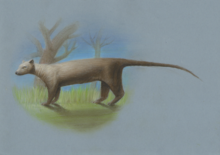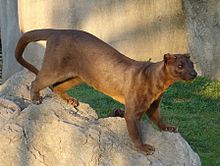Cryptoprocta spelea
| Cryptoprocta spelea Temporal range: Holocene
| |
|---|---|

| |
| Scientific classification | |
| Domain: | Eukaryota |
| Kingdom: | Animalia |
| Phylum: | Chordata |
| Class: | Mammalia |
| Order: | Carnivora |
| Suborder: | Feliformia |
| Family: | Eupleridae |
| Genus: | Cryptoprocta |
| Species: | †C. spelea
|
| Binomial name | |
| †Cryptoprocta spelea G. Grandidier, 1902
| |

| |
| Subfossil sites for Cryptoprocta species: blue—C. spelea; green—C. ferox and C. spelea; red—C. ferox[2] | |
| Synonyms[3] | |
| |
Cryptoprocta spelea, also known as the giant fossa,[4] is an extinct species of carnivore from Madagascar in the family Eupleridae which is most closely related to the mongooses and includes all Malagasy carnivorans. It was first described in 1902, and in 1935 was recognized as a separate species from its closest relative, the living fossa (Cryptoprocta ferox). C. spelea was larger than the fossa, but otherwise similar. The two have not always been accepted as distinct species. When and how C. spelea became extinct is unknown; there is some anecdotal evidence, including reports of very large fossas, that there is more than one surviving species.
The species is known from
Taxonomy
In 1902,
Lamberton recognized a third species, Cryptoprocta antamba, on the basis of a
Description

Although some
Distribution and ecology
| Site | spe. | fer. |
|---|---|---|
| Ankazoabo | + | |
| Antsirabe | + | + |
| Behova | + | + |
| Beloha | + | + |
| Belo sur Mer | + | + |
| Bemafandry | + | |
Betioky |
+ | |
| Lakaton'ny akanga | + | |
| Lelia | + | |
| Manombo | + | + |
| Tsiandroina | + | |
| Tsiravé | + | |
Abbreviations:
| ||
Subfossil remains of the giant fossa have been found in
With its large size and massive jaws and teeth,
Extinction
Why and when C. spelea went extinct is not known; it is possible that C. spelea went extinct before 1400.[30] C. spelea is on the IUCN Red List.[1]
Local people on Madagascar often recognize two forms of fossa, a larger fosa mainty (or "black Cryptoprocta") and a smaller fosa mena (or "reddish Cryptoprocta").[31] There are also some anecdotal records of very large living fossas, such as a 2 m (7 ft), 30 kg (70 lb) fossa at Morondava. Goodman and colleagues suggested that further research may demonstrate that there is more than one species of fossa yet alive.[2]
C. spelea is the only extinct carnivoran mammal known from Madagascar;[7] recently extinct (non-carnivoran) Madagascan animals also include large lemurs,[15] elephant birds, and Malagasy hippopotamuses.[32]
The extinction of C. spelea may have changed predation dynamics on Madagascar.
References
- ^ . Retrieved 27 March 2021.
- ^ a b c d Goodman et al., 2004, p. 141
- ^ a b c Goodman et al., 2004, p. 130
- ^ Alcover and McMinn, 1994, table 1
- ^ Goodman et al., 2004, pp. 130–131
- ISSN 0374-5481.
- ^ a b Goodman et al., 2003, p. 1167
- ^ Goodman et al., 2004, p. 131
- ^ a b Goodman et al., 2004, p. 136
- ^ Goodman et al., 2004, pp. 136–137
- ^ Lamberton, 1939, p. 191
- ^ Lamberton, 1939, p. 193
- ^ Goodman et al., 2003, p. 1169; 2004, p. 131
- ^ Turvey, 2009, p. 34
- ^ a b Goodman et al., 2004, p. 137
- ^ Garbutt, 2007, p. 208
- ^ Lamberton, 1939, p. 182
- ^ Köhncke and Leonhardt, 1986, p. 2
- ^ Goodman et al., 2004, table 1
- ^ Personal communication from R. Dewer in Burness et al., 2001, table 1
- ^ Wroe et al., 2004, p. 297
- ^ Burness et al., 2001, table 1
- ^ Garbutt, 2007, p. 211
- ^ Goodman et al., 2003, pp. 1167–1168; 2004, pp. 140–141
- ^ Goodman et al., 2004, p. 138
- ^ Goodman, 2003, quoted in Colquhoun, 2006, p. 148
- ^ Goodman et al., 2004, pp. 138–140; Colquhoun, 2006, pp. 148, 156
- ^ Goodman, 2003, p. 1227
- ^ Alcover and McMinn, 1994, p. 14
- ^ Goodman et al., 2004, p. 140
- ^ Goodman et al., 2003, p. 1168; 2004, p. 141
- ^ Burney et al., 2004, p. 25
Literature cited
- Alcover, J.A.; McMinn, M. (1994). "Predators of Vertebrates on Islands". BioScience. 44 (1): 12–18. JSTOR 1312401.
- Burness, G.P.; Diamond, J.; Flannery, T. (2001). "Dinosaurs, dragons, and dwarfs: The evolution of maximal body size". Proceedings of the National Academy of Sciences. 98 (25): 14518–14523. PMID 11724953.
- Burney, D.A.; Burney, L.P.; Godfrey, L.R.; Jungers, W.L.; Goodman, S.M.; Wright, H.T.; Jull, A.J.T. (2004). "A chronology for late prehistoric Madagascar". Journal of Human Evolution. 47 (1–2): 25–63. PMID 15288523.
- Colquhoun, I.C. (2006). "Predation and Cathemerality". Folia Primatologica. 77 (1–2): 143–165. S2CID 34211531.
- Garbutt, N. (2007). Mammals of Madagascar: A Complete Guide. A & C Black. ISBN 978-0713670431.
- Goodman, S.M. (2003). "Predation on lemurs". In Goodman, S.M.; Benstead, J.P. (eds.). The Natural History of Madagascar. University of Chicago Press. pp. 1221–1228. ISBN 0226303063.
- Goodman, S.M.; Ganzhorn, J.U.; Rakotondravony, D. (2003). "Introduction to the mammals". In Goodman, S.M.; Benstead, J.P. (eds.). The Natural History of Madagascar. University of Chicago Press. pp. 1159–1186. ISBN 0226303063.
- Goodman, S.M.; Rasoloarison, R.M.; Ganzhorn, J.U. (2004). "On the specific identification of subfossil Cryptoprocta (Mammalia, Carnivora) from Madagascar" (PDF). Zoosystema. 26 (1): 129–143. Archived from the original (PDF) on 27 November 2006.
- Hoffmann, M.; Hawkins, F. (2015). "Cryptoprocta spelea". . Retrieved 27 March 2021.
- Köhncke, M.; Leonhardt, K. (1986). "Cryptoprocta ferox". Mammalian Species (254): 1–5. JSTOR 3503919.
- Lamberton, C. (1939). "Les Cryptoprocta fossiles". Mémoires de l'Académie malgache. 27: 155–193.
- Turvey, S.T. (2009). "In the shadow of the megafauna: prehistoric mammal and bird extinctions across the Holocene". In Turvey, Samuel T (ed.). Holocene Extinctions. Oxford University Press. pp. 17–40. ISBN 978-0199535095.
- Wroe, S.; Field, J.; Fullagar, R.; Jermin, L.S. (2004). "Megafaunal extinction in the late Quaternary and the global overkill hypothesis" (PDF). Alcheringa: An Australasian Journal of Palaeontology. 28 (1): 291–331. S2CID 84785550.

